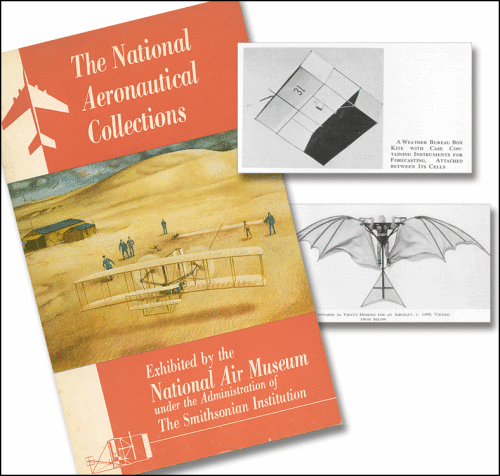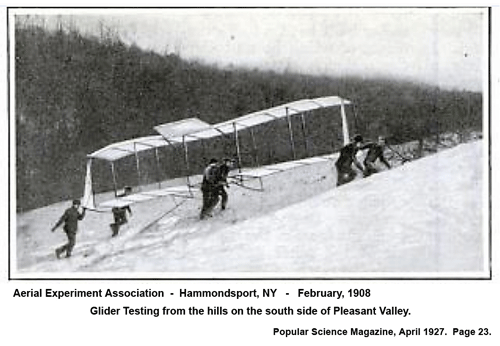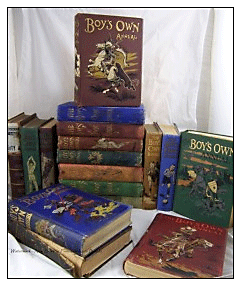From the Kite History Library
Topical insights into Kites and Kite Pioneers through history are presented with excerpts from books, documents, photos, journals, and digital archive files from my personal Kite History Library. Excerpts from interesting kite books for children are also featured from time to time.
_____________________________________________________________________________
The National Aeronautical Collections - Smithsonian Institute
The National Air and Space Museum of the Smithsonian in Washington, DC has one of the world's finest collections of historic flight artifacts. From the Wright Flyer through the Space Shuttle, the collection is absolutely superb and a mecca for anyone interested in flight.
The archives of the collection are purpoted to hold many smaller artifacts that would be of interest to kite flyers. For example, the collection includes a genuine Eddy War Kite and other kites from the golden age of kiting that are not generally on display
Periodically the museum publishes a kind of catalog overview booklet of significant items, mostly airplanes, in the collection. The publications are differentiated by the date of their publication and the focus of the collection at the time of print.
The 1956 version is of special interest to kiters.

Edited by Dr. Paul. E. Garber, Curator of the Museum at the time, the introductory section covers important ground in the history of kites leading up to early aviation.
This particular catalog covers aeronautical progress from the notions of fantasy of flight through early attempts to puzzle out the principles of aeronautics on to the fairly modern aircraft of the mid-1950's. The table of contents and illustrations provides and outline that shows a delightful homage to kites in the lead up to powered flight.
There are also plenty of acknowledgements of the work of Glenn Curtiss (one of the AEA Boys) as well as, of course, the Wrights. Good coverage is given to early thinkers from daVinci through Cayley on through Henson, Stringfellow, Penaud, Lillienthal, Chanute et al. This edition provides excellent coverage of the lively early aeronautical scene on the continent of Europe and England as well developments in North America.
It is a good little volume for the serious aficionado of early aeronautics and the role of kites in the very earliest notions of controlled flight.
Testing the AEA Glider - Winter 1908
In late December of 1907 the newly formed Aerial Experiment Association moved its centre of operations from the Alexander Graham Bell estate in Baddeck, Nova Scotia to Hammondsport, New York. The move was made to accommodate the construction of experimental "aerodromes" (aircraft) at the site of the Glenn H. Curtiss motorcycle plant in Hammondsport.
The construction and testing of a bi-plane glider was the first step by the AEA into building aircraft that were not based on tetrahedral kite construction. Previous work in Baddeck in the fall of 1907 had focused on testing the flight and man-lifting capability of the mammoth Cygnet kite created by Dr. Alexander Graham Bell.
In Hammondsport, a Chanute-type a glider was constructed to provide experience in constructing and flying an aerial device that would be similar to some of the emerging designs of other aeronautical pioneers pursuing the quest for controlled powered flight.

On January 13, 1908 the members of the AEA began flights with the glider on the hillsides just outside the village of Hammondsport.
Approximately fifty gliding flights were taken over two months. The initial flight was only a few feet long as the pilots struggled to find the balance point in the fledgling craft. By mid-March 1908 when they concluded work with the glider their flights were reaching the one hundred yard mark. The flights were mostly carried out by F.W. Casey Baldwin and Douglas McCurdy who stated that this experience served a very useful purpose by giving them a 'feel of the air' and how to balance a craft when it was airborn.
Prior to the glider flight test period, the members of the AEA had already determined that they would have to design a succession of machines, learning as they went, until they would be able to master all of the factors necessary to build, power, and manage the flight of an aerodrome. They decided that each member would be in charge of the design and construction of one machine. Early in January, as they finished work on the glider, they had already started the design of their initial aerodrome, the Red Wing. The aerodromes that followed were named: White Wing, June Bug, and Silver Dart.
The above photo is personal favourite from my kite library. To me it communicates a sense of enthusiasm, determination, and excitement as the AEA forged ahead with their quest "...to get into the air"!
_________________
Additional Reading:
- The Kites and Aerodromes of the Aerial Experiment Association.
- Members of the Aerial Experiment Association.
References:
Parkin, J. H. Bell and Baldwin: Their Development of Aerodromes and Hydrodromes at Baddeck, Nova Scotia. Toronto: University of Toronto Press. 1964 (555 pages)
C.R. Roseberry. Glenn Curtiss: Pioneer of Flight. Garden City, New York: Doubleday & Company, Inc. 1972. (514 pages) lIBRARY OF cONGRES nUMBER 70-171216
Charlotte Gray. Reluctant Genius: The Passionate Life and Inventive Mind of Dr. Alexander Graham Bell. Toronto: HarperCollins Publishers Ltd. 2006. (467 pages) ISBN-13: 978-0-00-200676-7
Frank Parker Stockbridge. Glenn Curtiss - Air Pilot No. 1. Popular Science Magazine, April 1927. Four pages beginning on Page 22. [Note: this is the second article in a four part series about aviation pioneer Glenn H. Curtiss.
Boys' Books Series Featured "How To" Entries on Kite Building.
The period from the late 1800's through the mid-1950's saw the regular publication of several Boys' Book Series that were published annually. These popular books were often given as gifts to the young boys in the family to both entertain them and to nurture their skills in building things and exploring the world.
These Annuals were different from the boy character literature series that were so popular in the early to mid 1900's (e.g. The Hardy Boys series of books) in that they focused on short stories of daring, adventure and science as well as having detailed descriptions and drawings of projects to be built by young fellows seeking to build real items that would provide some thrilling play experiences.
 The premier example of this type of series was the Boys Own Annual 1(see footnote) series that was published from 1884 through the 1970's. There were several other series produced by publishers who recognized the success of this format.
The premier example of this type of series was the Boys Own Annual 1(see footnote) series that was published from 1884 through the 1970's. There were several other series produced by publishers who recognized the success of this format.
The books suited the era. Every home seemed to have some type of tools and little workshop and many fathers were accomplished tinkerers and builders. So, having a book that would suggest things to build for young boys was logical and highly successful for the publishers. The series were such a money maker that publishers around the world got in on the act and published their own national versions of these books. Thus, Australia had The Australian Boys Annual and France, Holland, Germany, and Russia also produced versions in their respective language, tailored to the interest of youth in their nations.
Since kites were popular with boys and their use as scientific tools were being written about in newspapers, almost every edition of these annuals would have a few pages devoted to kite building.
The oldest of this type of book in my library is the 1844 faux-leather bound edition of the Boys' Own Book: A Complete Encyclopedia of All the Diversions of Boyhood and Youth. It actually predates the publication of the Boy's Own Annual versions, but it contains many of the same components that made the Boy's Own Paper and its annual companion such popular volumes with young boys.
Here is the excerpt on kites from pages 26-27:
The article includes a description and instructions for building an Arch Top kite, very popular in the early to late 1800's.
As the Boys' Books Series evolved over the years, different kites, in keeping with the era of publication, would be included in the annual. Other kite types featured over the years included: the Diamond or Tailless Malay, box kites, Conyne type kites, and bird shaped kites.
These books can be fine sources of information for kite builders and historians seeking to find kites that were applicable to various eras.
_____________________
Notes:
1. The Boy's Own Annual was based on the British paper The Boy's Own Paper which began publication in January 1879. The story paper was published on a periodic basis by the Religious Tract Society. later, other publishing houses took the publication over and continued it's run up until 1967. Beginning in 1879 the annual edition was bound into a large, attractive book and sold in book stores across the English speaking world. The Boy's Own Annual was published in a modified format until 1976. By then, the times had changed so much that this type of publication was no longer profitable.





